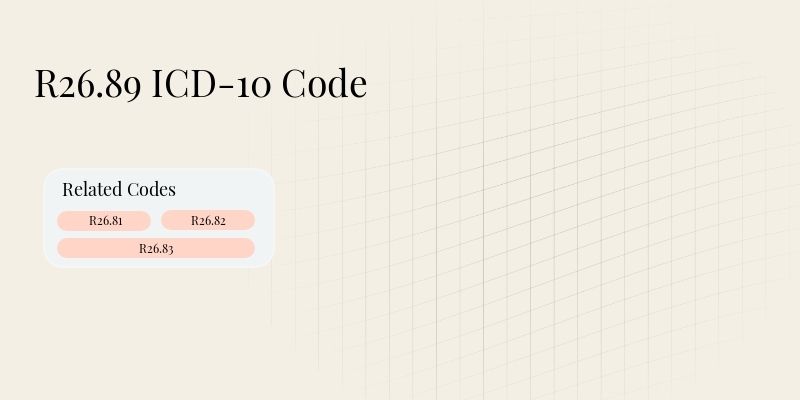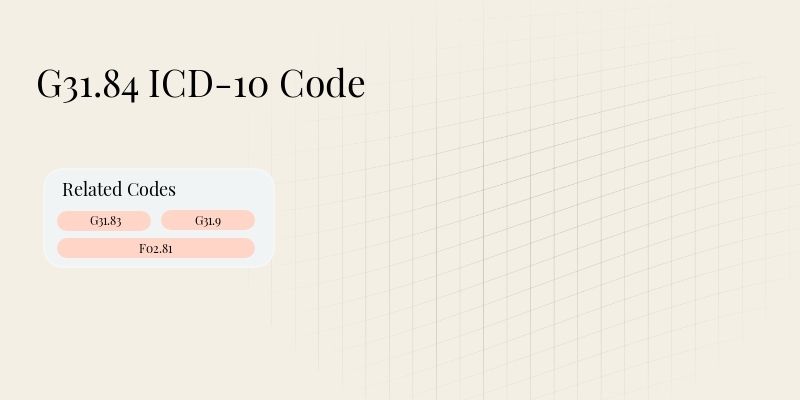
R26.89 ICD-10 Code: Ambulatory Dysfunction

Key Takeaways
- What R26.89 ICD-10 Code Covers: This code specifically pertains to ambulatory dysfunction, which refers to difficulties in walking or moving independently. It encompasses a range of conditions that affect mobility without specifying the underlying cause.
- Session duration requirements: There are no specific session duration requirements associated with this code; however, thorough documentation of the patient's condition and treatment plan is essential for accurate billing.
- Who can use the code: This code can be used by healthcare professionals including physicians, physical therapists, and occupational therapists who assess and treat patients experiencing mobility issues.
- Best practice for proper use: Ensure comprehensive documentation that outlines the patient's history, the specifics of their ambulatory dysfunction, and the interventions applied to support accurate coding and billing.
- Example of actual usage: A patient presenting with balance issues after a stroke may be coded with R26.89 during physical therapy sessions aimed at improving their gait and stability.
What is R26.89 ICD-10 Code
The R26.89 ICD‑10 code is designated for ambulatory dysfunction, a term that describes a range of conditions leading to difficulties in walking or maintaining mobility. It is crucial for healthcare providers to accurately identify this code in patients who experience challenges with their ambulation, as it assists in ensuring appropriate treatment and reimbursement.
Healthcare professionals must recognize that this code does not specify the underlying cause of the dysfunction, thereby allowing flexibility in its application across various clinical scenarios. Proper documentation is vital to support the use of this code, as it aids in clarifying the patient's condition and treatment rationale.
Services Covered Under R26.89 ICD-10 Code
This code encompasses a variety of services aimed at addressing ambulatory dysfunction. Below is a detailed table of services that can be billed under this code.
Service | Description |
|---|---|
Physical Therapy | Therapeutic exercises and interventions designed to improve mobility and strength. |
Occupational Therapy | Assistance with activities of daily living to enhance independence. |
Assistive Device Assessment | Evaluation for walkers, canes, or other devices to aid in ambulation. |
Balance Training | Specific exercises aimed at improving stability and reducing fall risk. |
Who Can Use the R26.89 ICD-10 Code?
This code can be used by a variety of healthcare professionals involved in diagnosing and treating ambulatory dysfunction. The following are key users of this code:
- Physicians: Medical doctors can use this code when diagnosing patients with mobility issues.
- Physical Therapists: These professionals often apply this code during treatment sessions aimed at enhancing mobility.
- Occupational Therapists: They can use the code when addressing the functional aspects of ambulation.
- Rehabilitation Specialists: Specialists in rehabilitation can also apply this code as part of comprehensive patient care.
How to Use R26.89 ICD-10 Code
When using the R26.89 code, it is vital to ensure clarity and specificity in documentation. Below are key points to consider:
- Document Patient History: Record any previous conditions or treatments related to mobility. For example, a history of stroke leading to walking difficulties.
- Detail Functional Limitations: Clearly outline how the patient's ambulation is affected, such as difficulty maintaining balance or walking without assistance.
- Specify Treatment Interventions: Include any therapies or exercises prescribed to address the dysfunction. For instance, a regimen focusing on strengthening lower limbs.
Reimbursement Rates for R26.89 ICD-10 Code
Below is a table comparing reimbursement rates for this code from various insurance providers.
Insurance Type | Average Reimbursement Rate |
|---|---|
Medicare | $75.00 |
Medicaid | $60.00 |
Private Insurance | $90.00 |
Disclaimer: Reimbursement rates can change frequently and are influenced by various factors. This article is updated regularly to reflect average prices.
Benefits of R26.89 ICD-10 Code
Understanding the advantages of using this code is essential for effective treatment and billing. The following benefits highlight its importance:
Benefit | Description |
|---|---|
Enhanced Treatment Planning | This code allows for targeted interventions specific to mobility issues, improving outcomes. |
Reimbursement Optimization | Accurate coding ensures appropriate reimbursement for services rendered. |
Improved Patient Tracking | Tracking patients with this code allows for better assessment of treatment efficacy over time. |
Common Mistakes to Avoid with R26.89 ICD-10 Code
Incorrect usage of this code can lead to audits, denials, and delayed reimbursements. Awareness of common pitfalls can mitigate these risks:
- Vague Documentation: Failing to provide specific details about the patient's dysfunction can lead to claims being denied. For instance, noting "difficulty walking" without elaboration.
- Using Incorrect Codes: Confusing this code with similar codes may result in inappropriate billing. For example, using a code for a specific injury rather than a general dysfunction.
- Neglecting Co-morbidities: Not documenting relevant co-existing conditions that contribute to mobility issues can weaken the claim's justification.
- Inadequate Treatment Records: Failing to document the interventions provided during therapy sessions can hinder reimbursement efforts.
R26.89 ICD-10 Code vs other codes
Comparing this code with other similar codes provides insight into its unique application. Below is a table highlighting distinctions between related codes.
Code | Description | Difference from R26.89 |
|---|---|---|
R26.81 | Unsteadiness on feet | Specifically addresses unsteadiness, while R26.89 covers broader ambulatory dysfunctions. |
R26.82 | Ataxic gait | Describes a specific type of gait abnormality, whereas R26.89 is more general. |
R26.83 | Other abnormal gait | This code is used for specific gait abnormalities not specified by R26.89. |
Conclusion
The R26.89 code for ambulatory dysfunction is essential for accurately documenting and billing for mobility‑related issues in patients. It covers a broad spectrum of conditions affecting walking and movement, allowing healthcare providers to tailor their treatment plans effectively. Proper usage involves meticulous documentation, including patient history, specific functional limitations, and treatment interventions. By understanding reimbursement rates and the benefits provided by this code, healthcare professionals can ensure optimal patient care and financial outcomes. Awareness of common pitfalls will further enhance coding accuracy, leading to fewer denials and a more streamlined billing process. Overall, mastering the application of this code is critical for effective patient management and successful practice operations.
Disclaimer: This article is for informational purposes only and does not constitute legal or medical advice. Always consult professional guidelines and regulatory bodies for specific compliance requirements.
Frequently Asked Questions
Reduce burnout,
improve patient care.
Join thousands of clinicians already using AI to become more efficient.

G31.84 ICD-10 Code: Cognitive Impairment
Discover essential insights on the G31.84 ICD-10 Code code for health professionals. Enhance your practice and navigate billing with confidence.

F84.0 ICD-10 Code: Guide to Autism Spectrum Disorder
Discover essential insights on the F84.0 ICD-10 code for mental health professionals. Enhance your practice and navigate billing with confidence.

90791 CPT Code: Psychiatric Diagnostic Interview Examination
Discover essential insights on the 90791 CPT Code code for health professionals. Enhance your practice and navigate billing with confidence.
